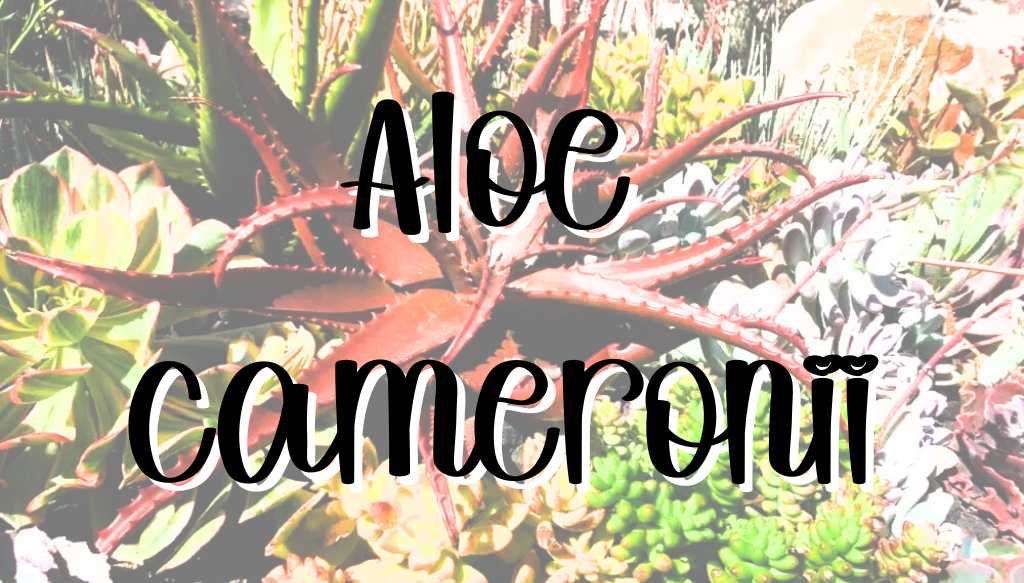Aloe cameronii, commonly known as the ‘Starfish Aloe’, is a beautiful and distinctive succulent plant native to Africa. Its striking appearance and unique features make it a popular choice for gardeners and plant enthusiasts. In this comprehensive guide, we will delve into the fascinating world of Aloe cameronii, exploring its origin, physical characteristics, growing conditions, planting and propagation methods, pests and diseases, and more. So, let’s get started and learn all about this remarkable plant!

Dig in!
The Origin of Aloe cameronii
Aloe cameronii hails from the arid regions of Malawi and Zimbabwe in southern Africa. It was first described by the British botanist Isaac Bayley Balfour in 1891. The plant’s unique features and ability to survive in harsh environments have allowed it to thrive in its native habitat, despite the challenges.
Physical Characteristics
Leaves
Aloe cameronii is known for its stunning red to copper-colored leaves, which give the plant its common name, ‘Starfish Aloe’. The leaves are long, narrow, and arch gracefully, creating an attractive rosette pattern. The leaf edges are lined with small, harmless teeth, giving the plant an added touch of visual interest.
Flowers
In addition to its eye-catching foliage, Aloe cameronii ‘Starfish Aloe’ produces tall, slender flower stalks that rise above the leaves. The tubular flowers are typically orange-red, but can sometimes appear in shades of yellow or green. They bloom from late autumn to winter, adding a dash of color to the garden during the colder months. The flowers attract lots of pollinators so be on the lookout for bees and hummingbirds!
Size
A mature Aloe cameronii plant can reach up to 2 feet in height and 3 feet in width. The flower stalks can grow an additional 2 to 3 feet, making this plant a striking focal point in any garden or landscape.
Growing Conditions
Soil Requirements
Aloe cameronii ‘Starfish Aloe’ thrives in well-draining soil, which is essential to prevent root rot. A mix of equal parts potting soil, coarse sand, and perlite or pumice is ideal. The soil should have a pH between 6.5 and 7.5 for optimal growth.

Consider amending your soil with Bonsai Jack’s gritty mix to ensure your succulent soil drains quickly to prevent it from staying moist for too long. Source: Etsy
Light Requirements
‘Starfish Aloe’ prefers full sun to light shade. In areas with intense summer heat, it may benefit from partial shade during the hottest part of the day. Too little sunlight can cause the leaves to lose their vibrant red color.
Watering
Aloe cameronii is drought-tolerant and requires minimal watering. During the growing season, water deeply but infrequently, allowing the soil to dry out between waterings. Reduce watering frequency during the winter months.
Temperature and Hardiness
Aloe cameronii ‘Starfish Aloe’ is hardy in USDA zones 9 to 11, tolerating temperatures down to 25°F (-4°C). It’s essential to protect the plant from frost, as it can cause significant damage or even death.

Care and Maintenance
Aloe cameronii requires minimal maintenance, but there are a few things you can do to keep it healthy and looking its best.
Pruning
Pruning and shaping ‘Starfish Aloe’ can help to promote new growth and prevent it from becoming too leggy or top-heavy. Fertilizing the plant during the growing season can also help to encourage healthy growth and vibrant coloration.
Repotting
If the plant outgrows its container, it can be repotted into a larger pot with fresh soil. It is important to avoid overwatering the plant after repotting, as this can lead to root rot.
When you’re rooting or transplanting your succulents and cacti, use SUPERthrive to help reduce the chance of transplant shock and grow a strong root system.
Planting and Propagation
Seeds
To propagate Aloe cameronii from seeds, sow them in a well-draining soil mix and keep the soil moist but not soggy. Place the seed tray in a warm, brightly lit location, and germination should occur within 2 to 4 weeks.
Offsets
Aloe cameronii ‘Starfish Aloe’ also produces offsets or “pups” that can be easily removed and replanted. Gently separate the offset from the parent plant, allowing the cut to dry for a day or two. Plant the offset in well-draining soil and water sparingly until new roots establish.
Pests and Diseases
Aloe cameronii is relatively resistant to pests and diseases, but it can fall victim to common succulent problems such as mealybugs, scale insects, and root rot. Regular inspections and proper care can help prevent these issues.
As an Amazon Associate I earn from qualifying purchases at no additional cost to you.
Fix the pest problem on your succulents and cacti with these popular insecticides.
Uses of Aloe cameronii
Ornamental
Aloe cameronii makes a stunning addition to any garden, landscape, or container arrangement. Its vibrant foliage and eye-catching flowers make ‘Starfish Aloe’ an excellent choice for rock gardens, succulent gardens, and xeriscapes.
Ecological
The tubular flowers of ‘Red Aloe’ attract pollinators such as bees, butterflies, and hummingbirds, making it an ecologically valuable addition to the garden.
Fun Facts About Aloe cameronii
- The red pigment in Aloe cameronii’s leaves is due to the presence of anthocyanins, which are also found in other red, blue, and purple plants.
- In its native habitat, Aloe cameronii often grows on rocky hillsides, demonstrating its ability to thrive in challenging conditions.
- Aloe cameronii is a member of the Asphodelaceae family, which includes around 500 species of Aloe and other related plants.
- The vibrant red color of the leaves intensifies when the plant is exposed to cooler temperatures or drought stress. Otherwise, Aloe cameronii will be a vibrant green color.
Aloe cameronii is a stunning and versatile plant that deserves a place in any succulent enthusiast’s collection. With its vibrant red leaves and attractive flowers, it adds a touch of elegance and color to the garden landscape. By following the care guidelines outlined in this comprehensive guide, you can ensure your Aloe cameronii ‘Starfish Aloe’ thrives and showcases its full potential.
Frequently Asked Questions
- How often should I water my Aloe cameronii?
Water deeply but infrequently during the growing season, allowing the soil to dry out between waterings. Reduce the watering frequency during the winter months. - Can Aloe cameronii grow indoors?
Yes, it can be grown indoors, provided it receives adequate light. Place it near a south-facing window or supplement with artificial light to maintain its vibrant leaf color. Typically, the lighting indoors isn’t enough for it to keep its deep red color so it will revert back to green. - How long does it take for Aloe cameronii to flower?
It typically blooms from late autumn to winter, although this may vary depending on the growing conditions and the plant’s overall health. - Do I need to fertilize my Aloe cameronii?
It benefits from occasional fertilization during the growing season. Use a balanced, liquid fertilizer diluted to half strength, applying it once every 4 to 6 weeks. - Are the leaves edible?
While some Aloe species, such as Aloe vera, are known for their edible and medicinal uses, it is not recommended to consume Aloe cameronii leaves. Stick to using the sap topically for minor skin irritations and injuries.

Where to Buy Succulents Online












